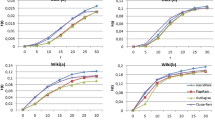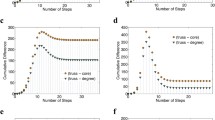Abstract
In recent days mobile network platforms enables communication among a wide range of people especially, sharing multimedia contents such as text, image, video, and audio to larger scale of users. This data sharing is intriguing, and it would reach a wider audience if a powerful individual shared it. However, locating influential users in a complex network is very difficult task. Traditional approaches for influential user selections are not so effective in spreading information on a big scale in a shorter period of time. To address these issues, this paper proposes a Fine-Tuned Linear Threshold Model (FTLTM) for influential user selection and monitoring in a complex network. The random selection of initial threshold “q” for each inactive node at the time “t” and the weighted edge between an inactive node and active node at time “t − 1” is fine-tuned based on various network centrality measures. The experimental results are proven that the proposed FTLTM method brings better output in the influential user’s selection, monitoring, and spread of information in a large-scale network. Various real-time applications like raising awareness of an epidemic, marketing to promote a product are major applications of this proposed work.







Similar content being viewed by others
Data availability
The dataset used in this article available in online and the link is provided in the reference sections.
References
Aslay C, Lakshmanan LV, Lu W and **ao X (2018) Influence maximization in online social networks. In: Proceedings of the Eleventh ACM International Conference on Web Search and Data Mining, pp 775–776
Sapountzi A, Psannis KE (2018) Social networking data analysis tools & challenges. Future Gener Comput Syst 86:893–913
Vamsidhar S, Babu MSK (2017) Suggestive node tracking enterprising reception network using stream influence maximization. Int J Res 4:3518–3524
Chen W, Ruihan Wu, Zheng Yu (2020) Scalable lattice influence maximization. IEEE Trans Comput Soc Syst 7(4):956–970
Deng X, Long F, Li B, Cao D, Pan Y (2020) An influence model based on heterogeneous online social network for influence maximization. IEEE Trans Netw Sci Eng 7(2):737–749. https://doi.org/10.1109/TNSE.2019.2920371
Dhobale M, Lande B, Nigho R, Waghi R (2018) Emphatic of social media. Int J Res Anal Rev 5:806–1808
Zhang H, Liu J, Kato N (2016) Threshold tuning-based wearable sensor fault detection for reliable medical monitoring using Bayesian network model. IEEE Syst J 12:1886–1896
Ohsaka N, Maehara T and Kawarabayashi K-I (2015) Efficient page rank tracking in evolving networks. In: Proceedings of the 21th ACM SIGKDD International Conference on Knowledge Discovery and Data Mining, pp 875–884
Hosseini-Pozveh M, Zamanifar K, Naghsh-Nilchi AR (2017) A community-based approach to identify the most influential nodes in social networks. J Inf Sci 43:204–220
Li W, Mo J, Liu Y, Ito N, Murase Y and Liu J (2018) The influence maximization problem in the network under node personalized characteristics. In: IEEE 16th Intl Conf on Dependable, Autonomic and Secure Computing, pp 216–221
Chen X, Song G, He X and **e K (2015) On influential nodes tracking in dynamic social networks. In: Proceedings of the 2015 SIAM International Conference on Data Mining, pp 613–621
Abdallah R and Sakoda K (2019) "Robust data routing in wireless networks with directional transmissions. ed: Google Patents
Sha M, Li Y, Wang Y, Guo W and Tan K-L (2018) River: a realtime influence monitoring system on social media streams. In: 2018 IEEE International Conference on Data Mining Workshops (ICDMW), pp 1429–1434
Rahimkhani K, Aleahmad A, Rahgozar M, Moeini A (2015) A fast algorithm for finding most influential people based on the linear threshold model. Expert Syst Appl 42:1353–1361
Zhu W, Yang W, Xuan S, Man D, Wang W, Du X et al (2019) Location-based seeds selection for influence blocking maximization in social networks. IEEE Access
He Q, Wang X, Lei Z, Huang M, Cai Y, Ma L (2019) TIFIM: a two-stage iterative framework for influence maximization in social networks. Appl Math Comput 354:338–352
Willis A, Fisher A, Lvov I (2015) Map** networks of influence: tracking Twitter conversations through time and space. Participations 12:494–530
Wang Z, Li Z, Yuan G, Sun Y, Rui X, ** communities in dynamic social networks. Knowl-Based Syst 157:81–97
Maheswari P, Jaya Krishna K (2018) A greedy algorithm approach for influential node tracking on dynamic social network. Int J Sci Res Comput Sci Eng Inf Technol 3(4):1272–1277
Al-garadi MA, Varathan KD, Ravana SD (2017) Identification of influential spreaders in online social networks using interaction weighted K-core decomposition method. Physica A 468:278–288
He J (2017) Relationship identification across heterogeneous online social networks. Comput Intell 33(3):448–477
Nepal S, Bista SK, Paris C (2015) Behavior-based propagation of trust in social networks with restricted and anonymous participation. Comput Intell 31(4):642–668
Bhanodia PK, Khamparia A, Pandey B (2021) Supervised shift k‐means based machine learning approach for link prediction using inherent structural properties of large online social network. Comput Intell 37:660–677. https://doi.org/10.1111/coin.12372
Li Q et al (2018) Group behavior diffusion model of social hotspots based on triadic structure and factor graphs. Comput Intell 34(4):1155–1177
Karimi-Majd A-M, Fathian M (2017) Multiobjective approach for detecting communities in heterogeneous networks. Comput Intell 33(4):980–1004
Umer M (2021) Sentiment analysis of tweets using a unified convolutional neural network-long short-term memory network model. Comput Intell 37(1):409–434
Fernández Vilas A, Díaz Redondo RP, Khalifa MB (2019) Analysis of crowds’ movement using Twitter. Comput Intell 35(2):448–472
Ge J et al (2021) LPX: overlap** community detection based on X-means and label propagation algorithm in attributed networks. Comput Intell 37(1):484–510
https://github.com/jamesrawlins1000/Telecom-CDR-Dataset-/blob/master/Call%20Details-Data.csv
Alhijawi B, Obeid N, Awajan A (2022) New hybrid semantic-based collaborative filtering recommender systems. Int J Inf Tecnol 14:3449–3455
Soni J, Mathur K (2022) Sentiment analysis based on aspect and context fusion using attention encoder with LSTM. Int J Inf Tecnol 14:3611–3618
Akuma S, Lubem T, Adom IT (2022) Comparing Bag of Words and TF-IDF with different models for hate speech detection from live tweets. Int J Inf Tecnol 14:3629–3635
Author information
Authors and Affiliations
Corresponding author
Ethics declarations
Conflict of interest
All authors have participated in (a) conception and design, or analysis and interpretation of the data; (b) drafting the article or revising it critically for important intellectual content; and (c) approval of the final version. This manuscript has not been submitted to, nor is under review at, another journal or other publishing venue. The authors have no affiliation with any organization with a direct or indirect financial interest in the subject matter discussed in the manuscript.
Rights and permissions
Springer Nature or its licensor (e.g. a society or other partner) holds exclusive rights to this article under a publishing agreement with the author(s) or other rightsholder(s); author self-archiving of the accepted manuscript version of this article is solely governed by the terms of such publishing agreement and applicable law.
About this article
Cite this article
Kumaran, P., Sridhar, R. & Muthuperumal, S. FTLTM: Fine Tuned Linear Threshold Model for gauging of influential user in complex networks for information diffusion. Int. j. inf. tecnol. 15, 3593–3604 (2023). https://doi.org/10.1007/s41870-023-01387-4
Received:
Accepted:
Published:
Issue Date:
DOI: https://doi.org/10.1007/s41870-023-01387-4




